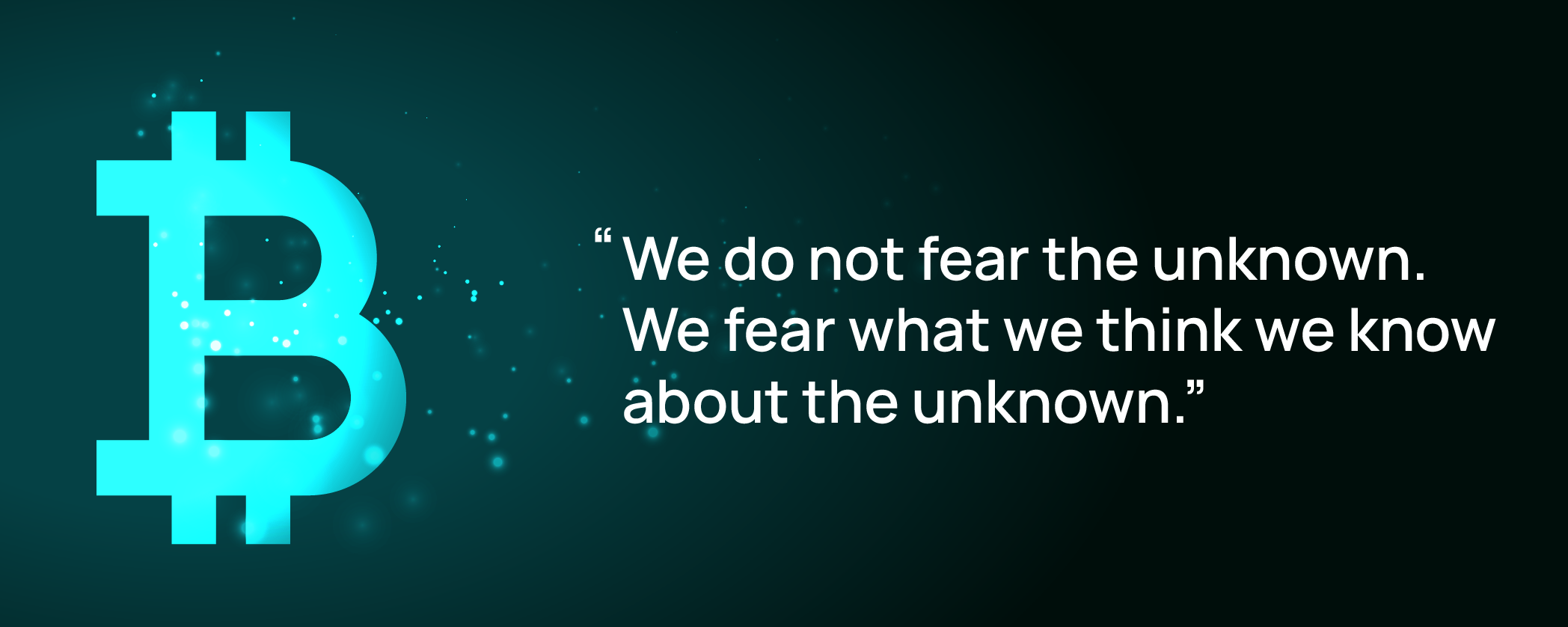5 misconceptions about Bitcoin

"We do not fear the unknown. We fear what we think we know about the unknown."
If you’re not already investing in Bitcoin or other cryptocurrencies, you might still be feeling unsure about digital currencies, or maybe just don’t know where to start. Here at Bit.com, we want to help clear up some misconceptions many might have about Bitcoin, and help make it easy for you to start the exciting journey of investing in cryptocurrency.
But first, let’s give you a quick idea of what Bitcoin (BTC) is.
Bitcoin works like digital money. Just like the US Dollar, Euro, or Japanese Yen, BTC is its own currency that lives on the internet. Like regular money, it can be used to buy both on and offline products and services, traded with other types of online currencies, and changes value from time to time.
It is decentralized and 100% transparent. This means that it’s not controlled by any government or bank, and the public can access, at any time, every single transaction made for every “dollar”. That’s because every transaction is recorded on a chain of events for that very “dollar” you are using, this is also called a blockchain.
It’s Peer-2-Peer, or P2P. When we make an online money transfer to a friend, there’s always a middle person, such as a bank, who makes that transaction happen. But with BTC, it’s like passing the money hand-to-hand, straight to the other person. This just means it’s safer (no more waiting for “the bank to process the payment”) and instantaneous.
Today, since its launch in 2009, BTC’s value has gone from practically zero in its initial months, to a high of 1 (the Bitcoin unit of measurement) BTC : US$64,800 in April 2021, and has been fluctuating around US$20,000 in the second half of 2022, so far. Volatility is very real in the world of crypto, and that’s where investors can find opportunities to make bank by timing it right.
Now that we have a clearer idea of what Bitcoin is, let us talk about some of the misconceptions people have of Bitcoin, and provide some accurate information.
1. Bitcoin is a bubble
First, let’s try to understand the expression “Bitcoin bubble”. In financial terms, a “bubble” is when an asset stays stagnant (price doesn’t change) for the longest time, then explodes, and its price skyrockets. When the bubble bursts, the asset’s price drops down as quickly as it rose.
If we look at the price of BTC, it did start out with little or no value, then rose suddenly before a drop which was almost as sudden. However, to define it as a “bubble”, the price has to drop back to almost zero, which is not the case for BTC. It has even stabilized and is showing some early signs of recovery, compared to some other cryptocurrencies, which have little or no value now.
BTC is also being used by many people, even some Burger King restaurants, Etsy shops, and Coca Cola vending machines, as an accepted form of payment. And many have even coined it as a real store of value. Sure, the price movement of BTC, like any cryptocurrency, is very volatile. But something we can be sure of is that BTC isn’t a bubble and there hasn’t been a burst. And its significance in today’s society is only set to grow even bigger.
2. It is completely anonymous, which favors criminals
When you use cash to buy something, once the cash leaves your hands, there’s no way to trace it. But that’s not the case for Bitcoin. It’s more like a huge data ledger, and every crypto transaction ever made is recorded on the blockchain. When an investigation is required, law enforcement agencies are able to track down money trails and trace activity back to the guilty parties. Everyone has access to every Bitcoin transaction. They are stored publically and permanently on the network.
While that might be the case, some illegal operations still go out of their way to modify or hide their user identity, just like Facebook accounts with fake names. There are also plenty of businesses set up to track and report money laundering to cryptocurrency exchanges and financial institutions. So we’ll say that Bitcoin is pseudo-anonymous.
3. Bitcoin is not secure
Bitcoin uses cryptography to keep all transactions secure. Users and blockchain technology are constantly upgrading the system and looking for weaknesses to make it almost impossible to hack. How difficult? Well, let’s just say it’s as secure as your bank.
However, there have been cases where Bitcoin was stolen from a person’s wallet because a hacker hacked into an individual’s computer. With login IDs and passwords, a hacker can still access someone’s digital wallet to steal cryptocurrency. The blockchain is notoriously difficult to hack. And since all data is publicly available, there’re no secrets to steal.
Normal companies, however, are vulnerable to data breaches. But when you make any transaction on the blockchain, you don’t add any personal information such as passwords, credit card numbers, or your home address, so there’s nothing to worry about.
4. You cannot use Bitcoin to buy anything In Real Life (IRL)
Well, you might not be able to go down to your local grocers and pay with Bitcoin, yet, but how about electronics, clothes, air tickets, games, and even vacations? A simple Google for “Where can I spend Bitcoin” and you’ll get tons of legitimate websites that are accepting Bitcoin.
Countries like El Salvador and the Central African Republic have also made Bitcoin legal tender in their country. You can also use Bitcoin to make payments at Starbucks, Microsoft, AT&T, Travala, and PayPal.
5. Bitcoin is too volatile
Like we’ve mentioned above, the crypto market is indeed volatile. But whether Bitcoin is too volatile depends on your appetite for risk and investment style. Are you a HODLer (someone who holds on to their cryptocurrency for the long term)? Or are you a crypto investor looking to make a quick buck by spotting the market?

Bitcoin is one of the more stable coins in the world of crypto. When we look closer at global financial trends, the price of Bitcoin has dropped less than traditional stocks of numerous S&P 500 companies in the US markets over the past year. It has stayed in the $19,000–$20,000 range for the past month (Sep–Oct 2022) and might show signs of recovery. For us, we’ll like to HODL out and keep a close watch on the latest developments and news to see what’s going to happen next.
Looking to get into the game? It’s ok to start small. Start trading on Bit.com and Switch On Your Future.

